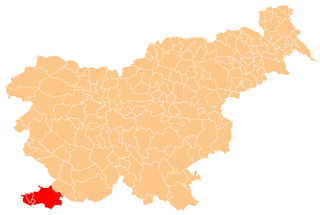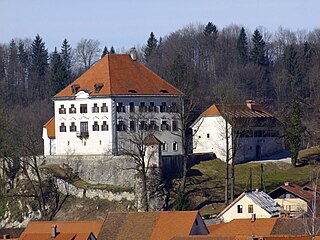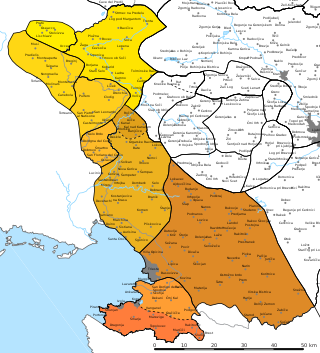
Istria is the largest peninsula within the Adriatic Sea. The peninsula is located at the head of the Adriatic between the Gulf of Trieste and the Kvarner Gulf. It is shared by three countries: Croatia, Slovenia, and Italy. Croatia encapsulates most of the Istrian peninsula within Istria County.

Taja Kramberger is a Slovenian poet, translator, essayist and historical anthropologist from Slovenia. She lives in France.

Koper is the fifth largest city in Slovenia. Located in the Istrian region in the southwestern part of the country, approximately five kilometres south of the border with Italy and 20 kilometres from Trieste, Koper is the largest coastal city in the country. It is bordered by the satellite towns of Izola and Ankaran. With a unique ecology and biodiversity, it is considered an important natural resource. The city's Port of Koper is Slovenia's only container port and a major contributor to the economy of the Municipality of Koper. The influence of the Port of Koper on tourism was one of the factors in Ankaran deciding to leave the municipality in a referendum in 2011 to establish its own municipality. The city is a destination for a number of Mediterranean cruising lines. Koper is the main urban centre of the Slovenian Istria, with a population of about 25,000. Aleš Bržan is the current mayor, serving since 2018.

Piran is a town in southwestern Slovenia on the Gulf of Piran on the Adriatic Sea. It is one of the three major towns of Slovenian Istria. The town is known for its medieval architecture, with narrow streets and compact houses. Piran is the administrative seat of the Municipality of Piran and one of Slovenia's major tourist attractions. Until the mid-20th century, Italian was the dominant language, but it was replaced by Slovene following the Istrian exodus.

The Austrian Littoral was a crown land (Kronland) of the Austrian Empire, established in 1849. It consisted of three regions: the Margraviate of Istria, Gorizia and Gradisca, and the Imperial Free City of Trieste. Throughout history, the region has been contested frequently, with parts of it controlled at various times by the Republic of Venice, Austria-Hungary, Italy, and Yugoslavia among others.

The Slovene Littoral is one of the five traditional regions of Slovenia. The littoral in its name - for a coastal-adjacent area - recalls the former Austrian Littoral, the Habsburg possessions on the upper Adriatic coast, of which the Slovene Littoral was part.

The Italian language is an officially recognized minority language in Slovenia, along with Hungarian. Around 3,700 Slovenian citizens speak Italian as their mother tongue, mostly Istrian Italians. Italian has a strong presence in Slovenia, both historical and current. An estimated 15% of Slovenians speak Italian as a second language, which is one of the highest percentages in the European Union.

Zoran Mušič, baptised as Anton Zoran Musič, was a Slovene painter, printmaker, and draughtsman. He was the only painter of Slovene descent who managed to establish himself in the elite cultural circles of Italy and France, particularly Paris in the second half of the 20th century, where he lived for most of his later life. He painted landscapes, still lifes, portraits, and self-portraits, as well as scenes of horror from the Dachau concentration camp and vedute of Venice.
Gravisi–Buttorai Mansion is a mansion in Koper, a port town in southwestern Slovenia. It is a protected monument of local significance. The mansion is situated at Shoemaker's Street in the old town center. It was the seat of a branch of the Gravisi family, whose senior line had the title of Marquis of Pietrapelosa, first granted to Nicolò Gravisi in 1440.

Gravisi–Barbabianca Mansion is a Baroque mansion in Koper, a port town in southwestern Slovenia. It was built in 1710. It was the family seat of the Gravisi family, who held the title of the Marquis of Pietrapelosa. Today it is the home of a music school.

Belgramoni–Tacco Mansion is a mansion in the city of Koper, in southwestern Slovenia. It was built around 1600. It features elements of Renaissance and Baroque, but in general has been regarded as a Mannerist building. The mansion currently serves as the seat of the Regional Museum of Koper. It is protected as a cultural monument of local significance.
TV Koper Capodistria is a Slovene free-to-air television channel based in Koper, Slovenia. Mainly funded by state aid, the channel serves the Italian-speaking minority in Slovenia and Croatia. It can also be received in the Italian region of Friuli-Venezia Giulia.

Marta Verginella is a Slovenian historian from the Slovene minority in Italy in Trieste, notable as one of the most prominent contemporary Slovene historians. Together with Alenka Puhar, she is considered a pioneer in the history of family relations in the Slovene Lands.

Istrian Italians are an ethnic group from the Adriatic region of Istria in modern northwestern Croatia and southwestern Slovenia. Istrian Italians descend from the original Latinized population of Roman Histria, from the Venetian-speaking settlers who colonized the region during the time of the Republic of Venice, and from the local Croatian people who culturally assimilated.

Slovene Istria is a region in southwest Slovenia. It comprises the northern part of the Istrian peninsula, and it is part of the wider geographical-historical region known as the Slovene Littoral. Its largest urban center is Koper. Other large settlements are Izola, Piran, and Portorož. The entire region has around 120 settlements. In its coastal area, both Slovene and Italian are official languages.

Zaprice Castle is a castle in Zaprice, now part of the town of Kamnik, Slovenia.

This article uses Logar transcription.
Radio Koper / Radio Capodistria is a radio station located in the city of Koper, Slovenia. It can be heard from Slovenia and northeastern part of Italy on the main frequency of FM 103.1 MHz. Good reception is possible on medium wave AM 1170 kHz in Slovenia, Croatia and North Italy. It is also available on the Satellite through Eutelsat 16A a 16°Est. Radio-Television Slovenia is the owner of the Radio.

Lucija Čok is a Slovene linguist, senior researcher in the field of multilingualism and a professor of multilingualism and intercultural communication. Throughout her career, she has held several important positions, including that of the Minister of Education, Science and Sport (2000-2002) of the Government of the Republic of Slovenia. In her role as the Minister, she contributed to the establishment of higher education institutions in the Slovene region of Primorska and in 2003 she was elected as the first rector of the newly established university. She participated in European Commission high expert panels that have shaped linguistic policies and strategies of higher education and research. She has facilitated the preparation of the formal basis for Slovenia’s integration into the European Research Area. She was an expert of the Institutional evaluation program board and member of the Council of the Slovenian Quality Assurance Agency for Higher Education. Her research work and publications focus on the formation of models of bilingual education in areas of linguistic and cultural contact, sociolinguistic and didactics of intercultural communication. In 2013, the University of Primorska named her professor emeritus. The same year, she received a lifetime achievement award for her work in the field of Higher Education by the Ministry of Education, Science and Sport.



















